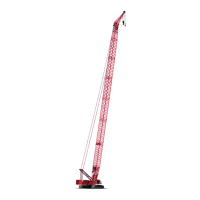Manitowoc Published 05-09-17, Control # 014-28 1-49
16000 SERVICE/MAINTENANCE MANUAL INTRODUCTION
Live Mast
See Figure 1-46 through Figure 1-49 for the following
procedure.
The live mast is the rectangular shaped structure that
supports the boom. The mast is also used for crane
assembly and disassembly.
The mast-raising sequence is controlled automatically by the
computer program and the boom/mast hoist control handle.
Mast raising and lowering rate is controlled by engine speed,
as it regulates pay out and haul in of the cable reeving
between boom/mast hoist sheaves and mast sheaves.
Mast system faults appear on the information screen when
the mast is inoperable in either direction or mast is at
maximum lower position. Stop operating when a fault
appears.
Mast Raising/Lowering with Mast Switch
See Figure 1-46 and Figure 1-49 for the following procedure.
The mast switch on hand-held wireless remote should only
be used for raising/lowering mast cylinders without wire rope
rigging. Power is available to hand-held wireless remote
control when engine is running, and power button is pressed.
When not enabled, mast raising cylinders are motor
spooled where both cylinder ports and tank port of valve
spool section are connected in center position. This type of
spool prevents premature opening of equalizing valves.
Load equalizing valves ensures mast-raising cylinders
operate in unison, protecting mast from structural damage
caused by twisting. Load equalizing valves also provides
support resistance against mast to ensure control of the unit
while rotating it at assembly. When an accessory valve spool
shifts, supply flow to the other accessory valves is limited.
The accessory system pressure sender monitors accessory
system pressure.
When mast cylinders switch is placed in the raise position
and held, an input voltage is sent to Node-1 controller. Node-
4 controller sends a 24 volt output to enable mast cylinders
raise solenoid HS-50 and shifts valve to the raise position.
Node-3 controller sends a variable zero to 24 volt output to
enable accessory system proportional relief solenoid HS-68.
See automatic raising/lowering procedure below for
complete cylinder operation.
When mast cylinders switch is released, solenoid HS-50
returns to center position. Node-3 controller sends a zero
volt output to disable accessory system proportional relief
solenoid HS-68.
When mast cylinders switch is placed in the lower position
and held, an input voltage is sent to Node-1 controller. Node-
4 controller sends a 24 volt output to enable mast cylinders
lower solenoid HS-51 and shifts valve to the lower position.
Node-3 controller sends a variable zero to 24 volt output to
enable accessory system proportional relief solenoid HS-68.
See automatic raising/lowering procedure below for
complete cylinder operation.
When mast cylinder switch is released, solenoid HS-50
returns to center position. Node-3 controller sends a zero
volt output to disable accessory system proportional relief
solenoid HS-68.
Mast Raising from Transport Position
See Figure 1-47 and Figure 1-49 for the following procedure.
Use RCL Screen to select the Liftcrane Mast Handling
Capacity Chart. The mast controls will not operate and the
mast operating limits remain off until the Liftcrane Mast
Handling Capacities Chart is selected.
Use mast switch on hand-held wireless remote to raise mast
assist arms until cylinders stall and stop.
When boom/mast hoist control handle is moved forward for
lowering, an input voltage of 2.4 volts or less is sent to
Node-1 controller. Node-3 controller sends a variable 0 to 24
FIGURE 1-46
Pressure
Sender
Accessory
Pump
Mast
Raising
Cylinders
Hand-Held
Wireless
Remote
HS-68
HS-51
HS-50
16-1036
500 to 3,000 psi
(35 to 204 bar)

